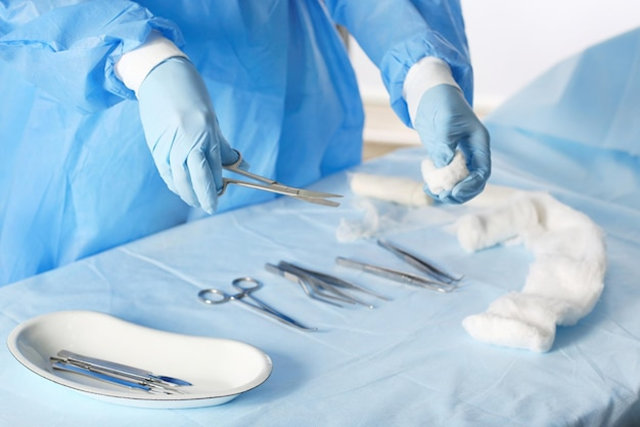Thyroid tumors encompass a range of abnormal growths within the thyroid gland, a butterfly-shaped organ in the front of the neck. These tumors can be benign (non-cancerous) or malignant (cancerous). While most thyroid tumors are benign, a small percentage can be cancerous, requiring medical intervention.
Thyroidectomy, the surgical removal of the thyroid gland, is a standard procedure to treat various thyroid conditions, including thyroid tumors. Thyroidectomy may be recommended for different reasons, such as the presence of cancer, large or growing cancerous thyroid nodules, or conditions like Graves’ disease or hyperthyroidism that are unresponsive to other treatments. The procedure aims to remove the affected thyroid tissue and, if necessary, nearby lymph nodes to prevent the spread of cancer or alleviate symptoms associated with benign tumors.
In this blog, we will learn about RABIT – Robotic Thyroidectomy, a groundbreaking treatment for thyroid cancer introduced by Dr. Sandeep Nayak, a renowned surgical oncologist in India.
Thyroidectomy – Traditional and Robotic
There are several approaches to thyroidectomy, including traditional open surgery and minimally invasive techniques like robotic or endoscopic procedures.
Traditional thyroidectomy
Traditional thyroidectomy involves a neck incision through which the thyroid gland is accessed and removed. This surgical technique has proven effective in treating thyroid tumors, providing an accurate diagnosis, and preventing the spread of malignant cells. However, it may involve a larger incision, resulting in longer recovery times and potential scarring.
RABIT (Robotic-Assisted Bilateral Axillo-Breast Approach Thyroidectomy)

In recent years, an innovative approach called RABIT has emerged as a minimally invasive alternative. RABIT utilizes robotic technology to access and remove the thyroid gland through small incisions in the axillary region. Robotic thyroid surgery causes minimal scarring and reduced post-operative pain. It provides a symmetrical view comparable to open surgery, enables specimen integrity maintenance, and offers excellent cosmetic outcomes.
“RABIT combines the advantages of a minimally invasive approach with the precision and accuracy of robotic technology,” explains Dr. Sandeep Nayak, often regarded as the best oncologist in India. “It offers patients reduced discomfort, faster recovery times, and improved cosmetic satisfaction.”
Overall, traditional thyroidectomy has a proven track record in treating thyroid tumors. At the same time, RABIT represents an exciting advancement in thyroid surgery, providing patients with additional options for a more minimally invasive and aesthetically pleasing approach.
The suitability of RABIT for each patient is determined through careful evaluation by a surgical oncologist, considering factors such as:
- tumor characteristics
- patient preference
- individual suitability for the procedure
If you are living with thyroid cancer, please consult surgical oncologist Dr. Sandeep Nayak to determine the most appropriate surgical technique based on your needs and considerations.
Tumor types and how RABIT helps
| Type | Description | Role of RABIT |
| Benign thyroid cancer | Non-cancerous thyroid nodules or growths in the thyroid gland | RABIT helps in providing accurate diagnosis and alleviating symptoms. RABIT offers a minimally invasive approach, reducing post-operative pain and scarring for benign tumor removal. |
| Malignant | Cancerous growths in the thyroid gland | RABIT aids in accurate staging and preventing the spread of cancer cells. It provides a precise and symmetrical view for the accurate removal of malignant tumors, ensuring optimal treatment outcomes. |
| Papillary carcinoma | The most common type of thyroid cancer | RABIT allows for the careful removal of papillary cancer of the thyroid, reducing the risk of cancer spread and achieving excellent cosmetic results. |
| Follicular tumor | A less common type of thyroid cancer | RABIT’s robotic-assisted approach aids in the precise removal of follicular carcinomas, minimizing surgical trauma and enhancing cosmetic outcomes. |
| Medullary thyroid carcinoma | Thyroid medullary cancer arises from C cells producing calcitonin | RABIT facilitates the safe and effective removal of medullary carcinomas, reducing post-operative pain and ensuring complete excision and optimal patient outcomes. |
| Anaplastic thyroid carcinoma | An aggressive and rare form of thyroid cancer | RABIT’s advanced technique supports the precise removal of anaplastic carcinomas with minimal scarring, providing improved outcomes and quality of life. |
Thyroidectomy is a highly individualized procedure tailored to the specific needs of each patient. If you or a loved one suspects a thyroid condition, please visit Laparoscopic surgeon Dr. Sandeep Nayak for an accurate diagnosis and effective treatment options.
Benefits of RABIT
The RABIT technique is a safe and viable method for thyroidectomy. It has numerous benefits, including:
Minimally invasive: RABIT offers a less invasive approach than traditional thyroidectomy, resulting in smaller incisions, reduced scarring, and minimal tissue trauma.
Improved cosmetic outcomes: The use of small, separate incisions in the breast-axillary region in RABIT leads to excellent cosmetic satisfaction and enhanced aesthetic results.
Clear and symmetrical view: RABIT provides a balanced view comparable to open surgery, allowing for the thorough removal of thyroid tumors while maintaining specimen integrity.
Reduced post-operative pain: The minimally invasive nature of RABIT leads to reduced post-operative pain and discomfort for patients, contributing to a faster recovery and improved overall experience.
Faster recovery time: RABIT enables patients to experience shorter recovery periods than traditional surgery, allowing them to return to normal activities more quickly.
Accurate tumor removal: RABIT’s robotic-assisted approach ensures the precise removal of benign and malignant thyroid tumors, reducing the risk of cancer spreading and promoting optimal treatment outcomes.
Enhanced patient satisfaction: The combination of minimally invasive techniques, improved cosmetic results, and reduced post-operative complications contribute to higher patient satisfaction levels with RABIT treatment.
“It is essential for patients to follow the post-operative care guidelines for a smooth recovery,” advises robotic surgical expert Dr. Sandeep Nayak.
Post-Operative Care
 Follow the surgeon’s instructions for wound care and incision site hygiene.
Follow the surgeon’s instructions for wound care and incision site hygiene.- Take prescribed pain medications as directed to manage discomfort.
- Gradually resume normal activities as advised by the surgical team.
- Avoid strenuous activities and heavy lifting for the recommended period.
- Maintain a balanced diet and stay hydrated to support healing.
- Attend follow-up appointments for post-operative evaluation and monitoring.
- Report any unusual symptoms, such as excessive pain, bleeding, or signs of infection, to the healthcare provider immediately.
- Wear compression garments or dressings as instructed to support healing and minimize swelling.
- Avoid exposing the incision site to excessive moisture or sunlight.
- Adhere to any dietary restrictions or recommendations provided by the healthcare team.
- Follow the prescribed medication regimen, including any thyroid hormone replacement therapy medication, to ensure proper hormone balance in the absence of a functional thyroid gland.
- Maintain regular communication with the healthcare team to address any concerns or questions during recovery.
“Regular follow-up visits and monitoring are essential to assess thyroid function,” advises surgical oncologist Dr. Sandeep Nayak. “This will help in managing potential complications and ensure optimal outcomes for the patient’s long-term health and well-being.”

